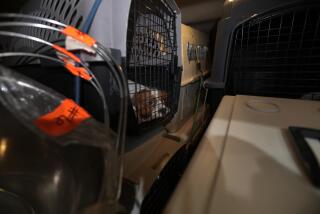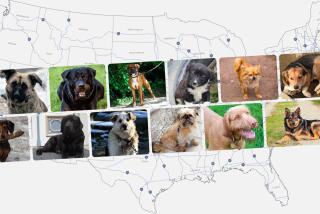Making it a journey fit for man and beast
- Share via
FOR about a week last fall, it seemed our 7-year-old yellow Labrador retriever might be crossing the Atlantic aboard the Queen Mary 2.
Although we often spoil Levon with table scraps and too much ball playing, we are not the sort who would dress a Chihuahua in diamonds or invest in weekly pet massages. We had planned to spend the year in Spain and wanted to take our dog with us but had heard horror stories about pets traveling on planes.
And so, with visions of lounging on deck, our hair/fur ruffled by sea breezes, we contacted Cunard, owner of the Queen Mary 2. But our plans for an ocean voyage were dashed when we learned that the line does not allow pets in the ship’s passenger cabins, so we began looking at other options.
Those intent on traveling with their pets, whether for a move or a vacation overseas or even domestically, will find obstacles similar to those we encountered, including figuring out how to get Fido to his destination and through many bureaucratic hoops.
Here are some of the options we considered.
* A ship trip: The Queen Mary 2, one of the few pet-friendly commercial cruise liners, turned out to be one of the less-expensive possibilities. The tab for our crossing would have been about $2,500, $500 of which would have been for Levon. The balance was for our interior cabin and the lowest-priced meal plan.
Pets stay in one of 12 kennels on the uppermost deck. There, an attendant prepares pets’ food (including special requests), and the animals can exercise in a shielded open-deck area.
Owners can visit and walk their pets during scheduled hours, but the animals are not allowed in passenger areas, a deal breaker for us.
* Chartering a plane: We briefly toyed with the idea. Levon could accompany us in the cabin, and we could even let him out of his crate. But when we saw the price, we came to our senses.
If money is no object, chartering a plane is certainly the easiest and least stressful way to travel with a pet. The price varies according to the company, departure point and destination, but plan on spending $70,000 to $80,000.
* Flying commercial: Small animals usually can travel in the cabin in a carrier, but a pet as large as Levon cannot.
Animal protection organizations contended for years that as many as 5,000 animals were injured or died during air travel each year, and some have urged owners not to ship their dogs as cargo on regular airlines.
In July 2005, the Department of Transportation began requiring airlines to keep track of the number of animals lost, injured or killed during flights.
“We weren’t crazy about the regulation originally, thinking it was just one more thing to keep track of,” said Lisa Schoppa, product development manager for Continental Airlines. Referring to the department’s findings, however, she added: “It’s brought out an interesting point. It’s not 5,000 who die each year, it’s not even 50.”
Since the airlines began keeping records last year, 22 animals have died aboard planes; 17 have been injured; and four have been lost. (That does not include Vivi, the whippet that bolted at JFK in February after winning a prize at the Westminster dog show.)
So we began considering airlines. Many don’t accept animals as cargo during the heat of summer; others don’t take pets at all.
Continental, which moves about 90,000 animals a year, offered the solution that best met our needs.
Commercial airlines that accept pets, including Continental, require large dogs to travel as cargo.
“The animals are put in a special hold that is heated or cooled to 60 degrees,” Schoppa said. “They breathe the same air as passengers in the cabin.”
Domestic pet transport costs $100 to $200 each way (often less in the cabin), but international travel is a different story. Flying our 85-pound dog and his crate to Spain would cost more than $1,500, about double the price of an off-season human ticket. Still, it was cheaper than any other option we had encountered, and we would even get frequent-flier miles for Levon.
We were reassured about Levon’s safety, but that didn’t mean we were worry-free.
Len Kain, co-founder of Dogfriendly.com, a website dedicated to pet travel, said he would take an animal on a plane only if it were necessary.
“It’s rare that dogs are killed or lost or injured,” Kain said, “but it’s pretty common that they’re traumatized.”
Which is what we were trying so hard to avoid.
Follow the rules
ONCE we had settled on the method of transport, we still had to deal with the regulations.
Some countries, including Japan and Australia, still require a quarantine in some situations, and much of the bureaucratic tape must be dealt with six months or more before the date of travel.
Pets imported into the European Union must have microchip or tattoo identifications and have a full veterinary work-up no more than 10 days before leaving home. Malta, Finland, Sweden, Ireland and Britain have additional requirements.
An animal’s health must also be certified by the U.S. Department of Agriculture immediately before departure, which meant sending our vet’s results overnight to a USDA vet so she could then overnight them back, with a federal seal of approval, the day before Levon’s departure.
Because we wanted to minimize the possibility that Levon would be lost or injured during a transfer, we decided he should fly nonstop from Newark, N.J., meaning one of us (Geoff in this case) had to drive him from our home near Cleveland to Newark.
At the Newark airport, employees at Continental’s QuikPak cargo desk took over. They quickly did the paperwork, pasted some “live animal” tape on the crate, then let Geoff take Levon out one last time on American soil.
Six hours later, Levon and master landed in Madrid. But it took two additional hours -- and a lot of running around -- before all the bureaucratic requirements had been met and we could reclaim our dog.
As we stood in a cargo terminal far from the airport itself, a forklift slowly approached, bearing a crate from which Levon peered forlornly. We opened the door, and he bolted out, squirming happily.
Quickly, we slipped him a slice of chorizo.
*
Begin text of infobox
Travels with Fido
WEBSITES:
If you’re taking the dog, here are sources that can help. Most airlines will not carry animals as cargo if temperatures are too hot, and some carriers ban some short-nosed breeds because of health concerns.
To read up on your airline’s rules, go to latimes.com/carriers. Enter “pets” in that carrier’s site search.
For information on international pet travel, see www.dogfriendly.com, www.petsonthego.com and www.petfriendlytravel.com. Also, see the website of the American Society for the Prevention of Cruelty to Animals (www.aspca.org; click on “Pet Care,” “Pet Care Tips” and “Air Travel Tips”).
QUARANTINE:
Rules on quarantine vary. For European Union country regulations (some have more stringent rules than others), go to www.ec.europa.eu/comm/food/animal/index_en.htm. For other countries, check with the embassy or consulate.
Britain’s rules have been stringent but have loosened recently. For information on its Pet Travel Scheme, call 011-44-8702-4117-10 8:30 a.m.-5 p.m. Mondays- Fridays (British time) or go to www.defra.gov.uk/animalh/quarantine/index.htm.
More to Read
Sign up for The Wild
We’ll help you find the best places to hike, bike and run, as well as the perfect silent spots for meditation and yoga.
You may occasionally receive promotional content from the Los Angeles Times.






